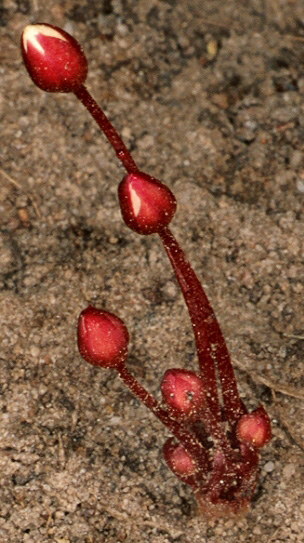Precocious little early bloomer
The plant of the month for August 2016 is Drosera praefolia, a rare South Australian endemic sundew with the peculiar trait of flowering before its leaves appear.
It is one of an amazing six sundew species found in Onkaparinga River National Park, which is the DEWNR Park of the Month for July. The other sundew species recorded there are the pink-flowered Drosera auriculata (tall sundew), the tiny D. glanduligera (scarlet sundew), D. hookeri (pale sundew), D. macrantha subsp. planchonii (climbing sundew) and D. whittakeri (scented sundew). This is a good time of year to see most of the species. Try the easy 5 km Sundews Ridge Hike or the steeper, more challenging 6 km Sundews River Hike.
Sundews (Drosera spp.) are insectivorous plants bearing stalked glands which produce a sticky mucilaginous material to attract and trap insects. These glandular hairs are responsive to pressure when an insect gets caught and bend in towards it to make further contact. Enzymes are secreted to digest the prey and release nutrients that the plant can absorb. The new treatment of the Flora of South Australia (5th edition) covering all the State’s Drosera species is available here as a pdf file (Conran & Marchant 2011; 3MB PDF).
Drosera praefolia resembles the more widespread and common Drosera whittakeri: both species are geophytes with their leaves arranged in a rosette that regrows each year from an underground tuber. Having this underground energy store from the previous season’s growth makes it possible for D. praefolia to flower much earlier and in advance of leaf production. Drosera praefolia flowers April to May and often produces mature seed before its leaves appear, in contrast to D. whittakeri which flowers July to October from fully-formed leaf rosettes.
Evolution of precocious flowering in D. praefolia may have been driven by natural selection to “beat the rush” and catch earlier pollinators in the face of strong competition during winter and spring when conditions are optimal for plant growth and subsequent flowering. Precocious flowering is also a feature of a number of late-summer and autumn flowering lilies, for example Calostemma, as featured in an earlier blog, and Crinum.
Pioneering South Australian botanist and entomologist Johann Gottlieb Otto Tepper described Drosera praefolia in 1892 (in German) drawing on collections and observations he made at Clarendon in the Onkaparinga River Valley ten years earlier while stationed there as a teacher.
However, D. praefolia was either disregarded or treated merely as an early-flowering variety of D. whittakeri for over a hundred years, until it was reinstated as a species by Bates (1991) (230KB PDF). This is despite its many other differences from D. whittakeri, including smaller flower size, a white (rather than orange) tuber, and leaves with shorter, non-ribbed petioles. For a full account, see the review of the Drosera whittakeri group by Lowrie & Conran (2008) (2.7MB PDF).
Contributed by State Herbarium botanist Peter J. Lang.




